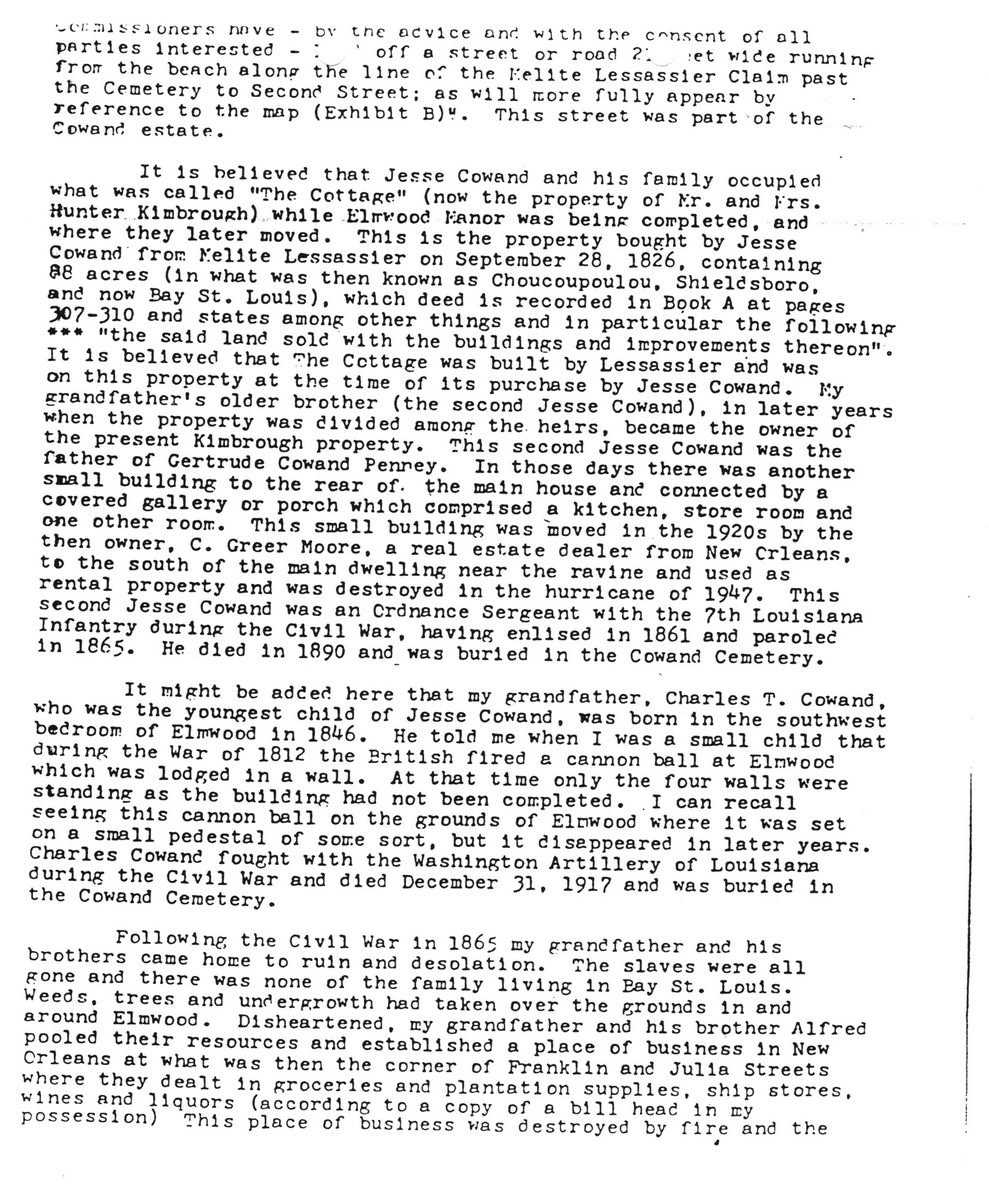This text was obtained via automated optical character recognition.
It has not been edited and may therefore contain several errors.
•_ t'l. .in t ? x oner s nnve - bv t.nc ocvlce on<i with the c^nscnt of oil parties Interested - I ' off a street or roacl .et vide running frorr the bench along the line of the Kellte Lessassier Claim past the Cemetery to Second Street; as will more fully appear by reference to the map (Exhibit B)V. This street was part of the ^ Cowand estate. It Is believed that Jesse Cowand and his family occupied what was called "The Cottage" (now the property of Mr. and I-rs. Hunter Kimbrough) while Elrrvood Kanor was belnr completed, and where they later moved. This Is the property bought by Jesse Cowand from Kellte Lessassier on September 28, 1826, containing 08 acres (In what was then known as Choucoupoulou, Shleldsboro, and now Bay St. Louis), which deed Is recorded In Book A at pages 307-310 and states among other things and In particular the following *** "the said land sold with the buildings and improvements thereon". It is believed that "he Cottage was built by Lessassier and was on this property at the time of its purchase by Jesse Cowand. Ky grandfather's older brother (the second Jesse Cowand), in later years when the property was divided among the heirs, became the owner of the present Kimbrough property. This second Jesse Cowand was the father of Gertrude Cowand Penney. In those days there was another snail building to the rear of. the main house and connected by a covered gallery or porch which comprised a kitchen, store roon and one other roorr. This small building was moved In the 1920s by the then owner, C. Creer Moore, a real estate dealer from New Orleans, t© the south of the main dwelling near the ravine and used as rental property and was destroyed in the hurricane of 19^7- This second Jesse Cowand was an Ordnance Sergeant with the ?th Louisiana Infantry during the Civil War, having enllsed In 1861 and paroled in I865. He died In 1890 and was burled In the Cowand Cemetery. It might be added here that my grandfather, Charles T. Cowand, who was the youngest child of Jesse Cowand, was born in the southwest bedroom of Elmwood In 18*4-6. He told me when I was a small child that during the War of 1812 the British fired a cannon ball at Elnwood which was lodged in a wall. At that time only the four walls were standing as the building had not been completed. I can recall seeing this cannon ball on the grounds of Elnwood where it was set on a small pedestal of some sort, but It disappeared In later years. Charles Cowand fought with the Washington Artillery of Louisiana during the Civil War and died December 31. 1917 and was burled In the Cowand Cemetery. Following the Civil War In 1865 my grandfather and his brothers came home to ruin and desolation. The slaves were all gone and there was none of the family living In Bay St. Louis. Weeds, trees and undergrowth had taken over the grounds In and around Elmwood. Disheartened, my grandfather and his brother Alfred pooled their resources and established a place of business In New Orleans at what was then the corner of Franklin and Julia Streets where they dealt In groceries and plantation supplies, ship stores, wines and liquors (according to a copy of a bill head In my possession) This place of business was destroyed by fire and the

Elmwood Plantation Document-(62)